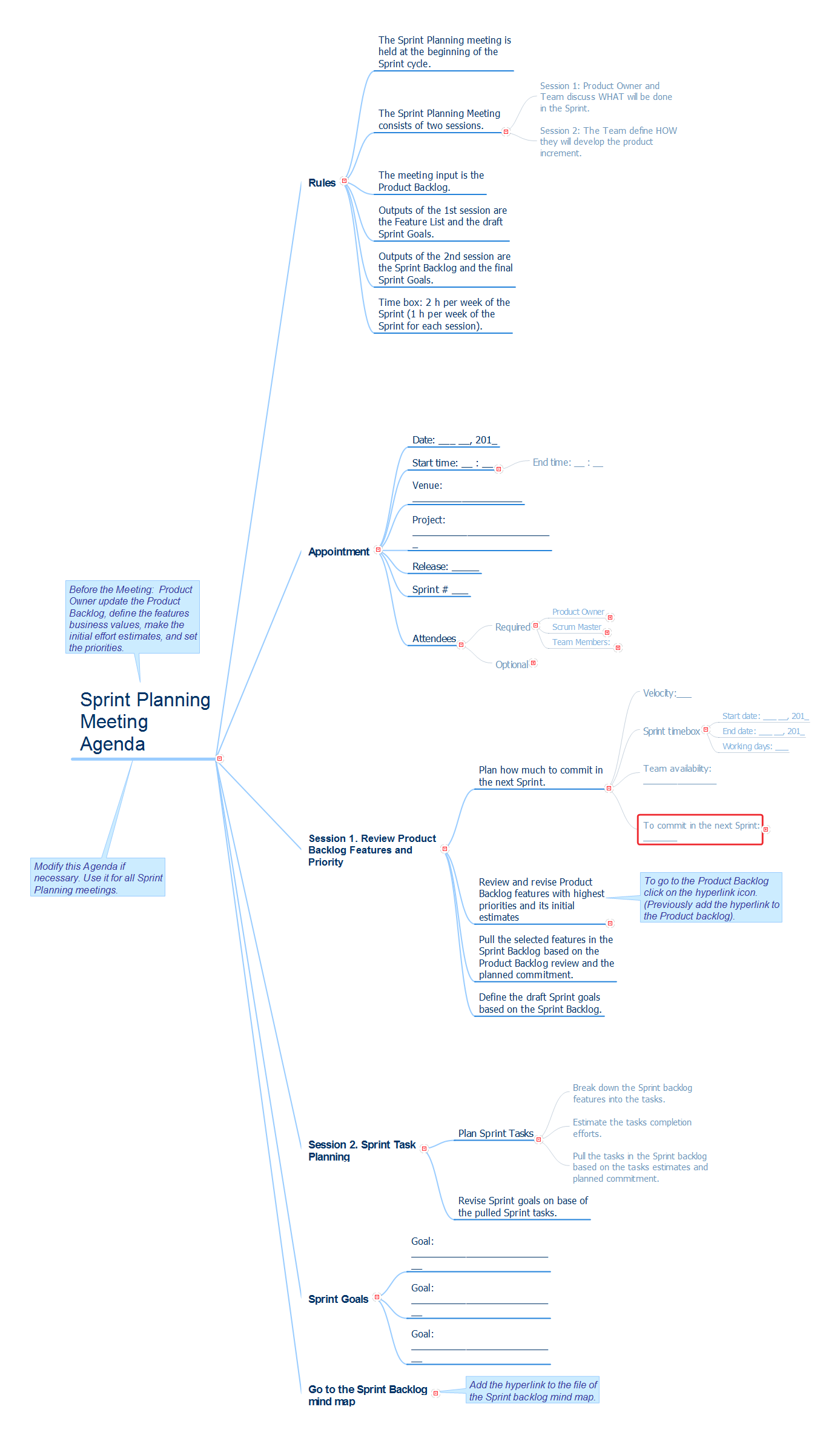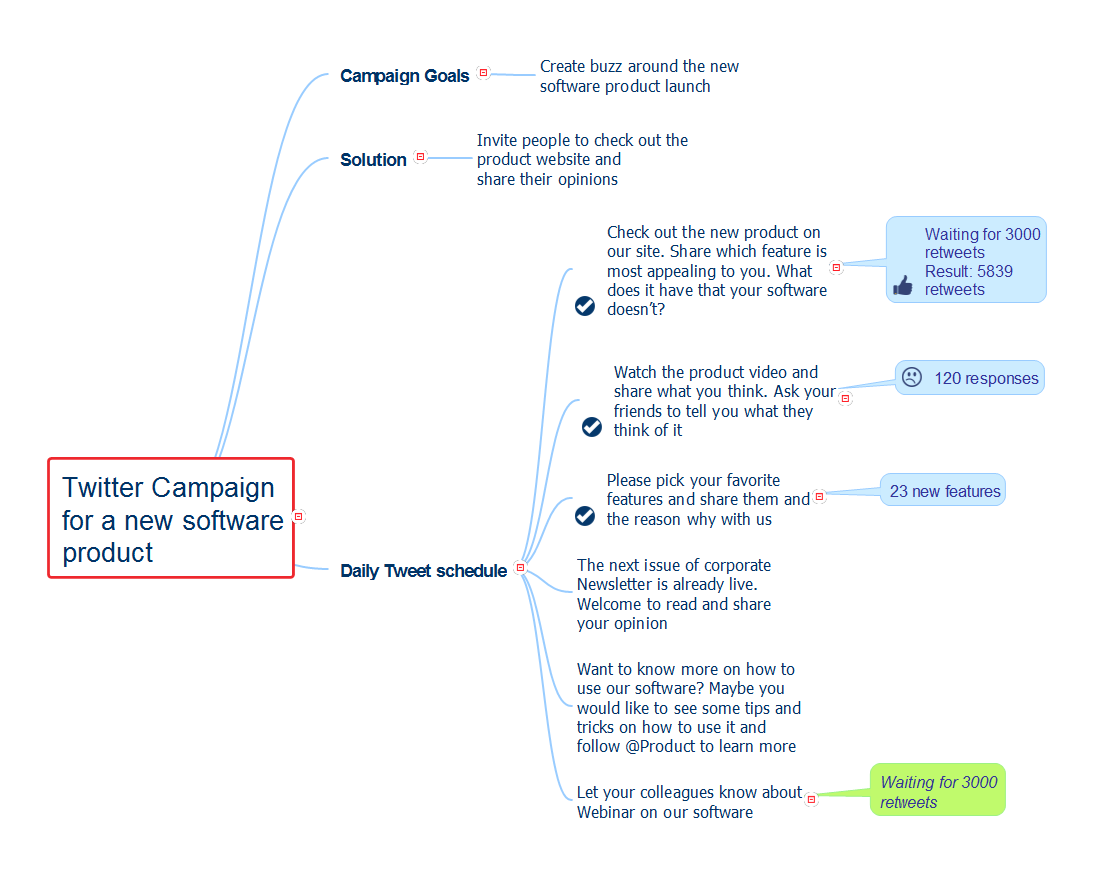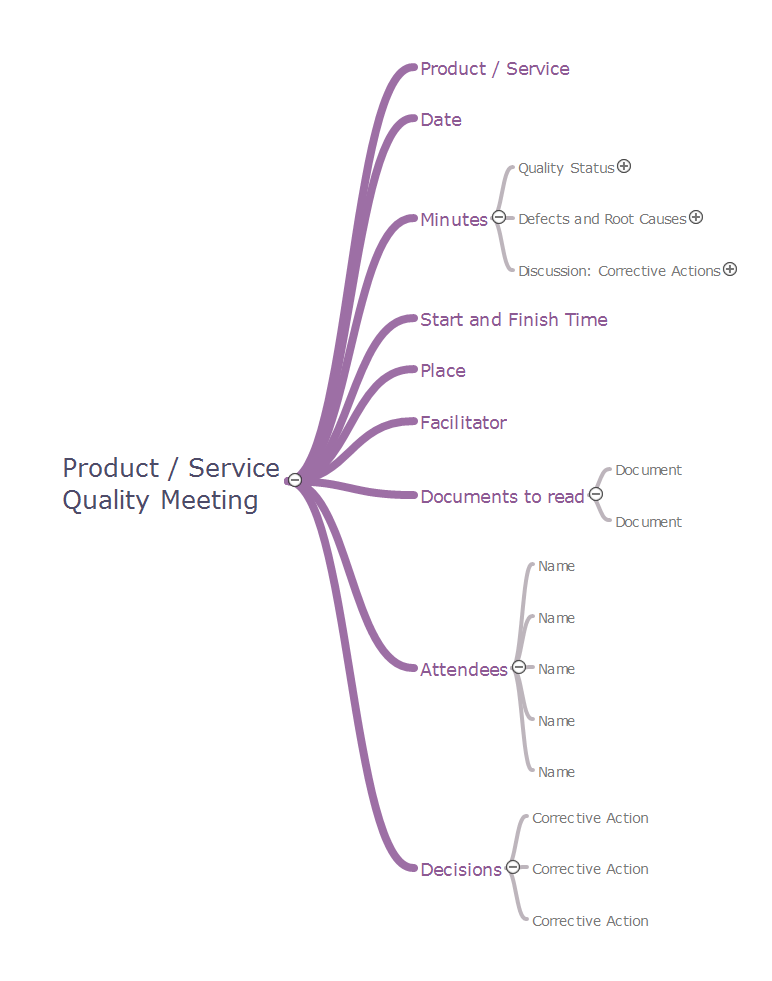Sprint Planning Meeting Agenda
Project ManagementIn PM solutions we support many project methodologies such as Agile and Simple Projects. Methodology solutions help in implementing best practices in project management. CS Odessa provides Toolbox solutions to support solving issues related to planning, tracking, milestones, events, resource usage, and other typical project management functions. Toolbox Solutions help you deal with common project situations in an extraordinary way. PM AgileBenefitsAll Agile meetings and documents are powered by mission adapted mind map templates, specially tuned for collaborative work. Tracking project Velocity is easy when using ConceptDraw Velocity diagram templates. ObjectiveSupport Agile methods such as user stories, iteration planning, burndown charts, backlogs, and velocity. Solution PurposeThese visual tools assist in the holding of Scrum-meetings, collaborative planning for Sprint, maintaining backlog, and calculating and reporting the Velocity of the team. Intended ForCompanies using Agile methodology; specifically, Scrum; Product Owners, Scrum Masters. Products and methodsIn the background of this solution we use mind mapping for visualization of key events and artifacts of Agile methodology. Key diagrams for visualization are made by ConceptDraw DIAGRAM |
Use Sprint Planning to visualize the Sprint Planning meeting agenda.

Example 1. Sprint Planning Meeting Agenda
Export to Outline
Sprint Planning Meeting Agenda
-
Rules
- The Sprint Planning meeting is held at the beginning of the Sprint cycle.
-
The Sprint Planning Meeting consists of two sessions.
- Session 1: Product Owner and Team discuss WHAT will be done in the Sprint.
- Session 2: The Team define HOW they will develop the product increment.
- The meeting input is the Product Backlog.
- Outputs of the 1st session are the Feature List and the draft Sprint Goals.
- Outputs of the 2nd session are the Sprint Backlog and the final Sprint Goals.
- Time box: 2 h per week of the Sprint (1 h per week of the Sprint for each session).
-
Appointment
- Date: ___ __, 201_
-
Start time: __ : __
- End time: __ : __
- Venue: ____________________
- Project: __________________________
- Release: _____
- Sprint # ___
-
Attendees
-
Required
-
Product Owner
- ______________________
-
Scrum Master
- ______________________
-
Team Members:
- ______________________
- ______________________
- ______________________
- ______________________
- ______________________
- ______________________
- ______________________
- ______________________
- ______________________
-
Product Owner
-
Optional
-
Project Sponsor:
- ______________________
-
Users:
- ______________________
- ______________________
- ______________________
-
Customers:
- ______________________
- ______________________
- ______________________
-
Managers:
- ______________________
- ______________________
- ______________________
-
Developers from other projects
- ______________________
- ______________________
- ______________________
-
Project Sponsor:
-
Required
-
Session 1. Review Product Backlog Features and Priority
-
Plan how much to commit in the next Sprint.
- Velocity:___
-
Sprint timebox
- Start date: ___ __, 201_
- End date: ___ __, 201_
- Working days: ___
- Team availability: _______________
-
To commit in the next Sprint: _______
- Determine how much the team is going to commit in the next Sprint based on the Velocity in the previous Sprints, the next Sprint Timebox, and the Team Availability.
-
Review and revise Product Backlog features with highest priorities and its initial estimates
- To go to the Product Backlog click on the hyperlink icon. (Previously add the hyperlink to the Product backlog).
- Pull the selected features in the Sprint Backlog based on the Product Backlog review and the planned commitment.
- Define the draft Sprint goals based on the Sprint Backlog.
-
Plan how much to commit in the next Sprint.
-
Session 2. Sprint Task Planning
-
Plan Sprint Tasks
- Break down the Sprint backlog features into the tasks.
- Estimate the tasks completion efforts.
- Pull the tasks in the Sprint backlog based on the tasks estimates and planned commitment.
- Revise Sprint goals on base of the pulled Sprint tasks.
-
Plan Sprint Tasks
-
Sprint Goals
- Goal: ___________________________
- Goal: ___________________________
- Goal: ___________________________
-
Go to the Sprint Backlog mind map
- Add the hyperlink to the file of the Sprint backlog mind map.
The Benefits for ConceptDraw MINDMAP Brainstorming Software
- ConceptDraw MINDMAP is effective for brainstorming, designing mind maps, idea generating, creative and lateral thinking, creativity and problem solving.
- ConceptDraw MINDMAP is ideal for team and personal work in Business, Marketing and Project Management.
- The libraries with large quantity of vector objects help to illustrate your mind maps and to make them bright, visual and comprehensible.
- Use of View Navigator tool lets create presentations from a mind map: you can simply select the map parts you want to present, sequence your slides, and preview the presentation.
- ConceptDraw MINDMAP provides wide capabilities of importing and exporting in various formats: Microsoft PowerPoint, Microsoft Word, MS Excel, Mindjet MindManager, image, HTML, PDF file.


